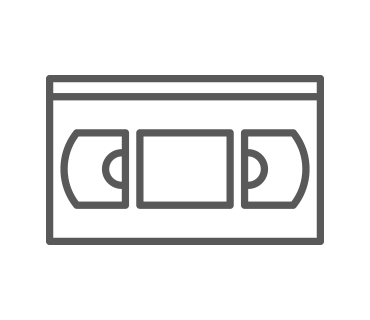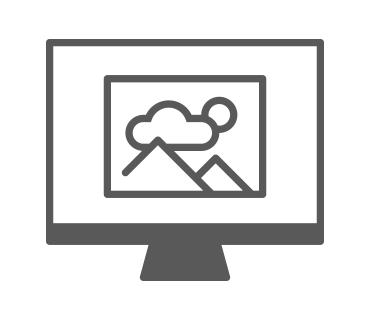Audio Dubbing – Here's How!
This is how to dub video:
- Open Movie Studio Platinum and drag & drop to import your video from the Media Pool onto the top track.
- To perform audio dubbing, drag additional audio files with music and sounds onto separate tracks. You can access many included songs from various genres in the Media Pool, as well as sound effects libraries that you can easily use for dubbing.
- To record a commentary track, click on the red record button. Start an audio recording and speak into your microphone while the video is played back. Your recording will appear in the project as an additional audio track.
- Open the audio mixer by pressing the "M" key and adjust the volume of all the audio tracks. Be sure to check the peak meter display to ensure that no clipping occurs. When in doubt, add a limiter to the master effects.
- For dynamic volume control, activate a volume curve in the context menu of the audio objects. Double-click on a curve and new curve handles will appear. Use these to freely adjust video volume of any audio track as desired. The "Automatically reduce volume" option ensures that the volume of all other audio tracks is lowered for the duration of an audio object.
- Once everything sounds good, go to "File" > "Export movie" and select an export format in the sub-menu (e.g. MP4). In this way, all the audio tracks you use will be exported together with the video track as a video file. You can also transfer the video directly to your smartphone or burn it to disc.
Dubbing audio to video using Movie Studio, the video editing software for downright amazing movies:
- Import all common audio and video formats
- Custom volume control via object handles
- Audio mixer for multiple audio tracks
- Increase volume using audio effects (normalization, compressor, 1-click effect templates)
- Mastering with multiband compressor for professional volume editing
- Track curves for dynamic volume control
- Helpful program wizards
- File conversion into all essential formats, CD burn function and direct transfer to smartphone
Audio dubbing – what you need to know
Apart from the moving images, videos almost always offer an corresponding audio track, which also has to be edited after recording. In most cases, this material alone is not enough to make an interesting film. If this is the case, it can be supplemented with further audio material such as music or sounds. The process of optimizing the audio track by adding additional recordings is called audio dubbing.
Generally, several audio files are combined with each other and background music, a narrator's commentary and additional tracks with sound effects are added to the original film's sound. It is necessary to optimize the sound and adjust the volume for all of these tracks so they're perfectly balanced. This will create a finished video containing a single stereo audio track with the ideal balance of volume for all the sources of sound.
Free video applications and shareware programs are overwhelmed by such demanding audio dubbing. Video and audio editing software Movie Studio Platinum provides a much better alternative. With this software, you can perform audio dubbing in addition to a number of professional video editing features.
Our step by step guide below shows you how to dub sound over video using Movie Studio.
Dub video with Movie Studio Platinum
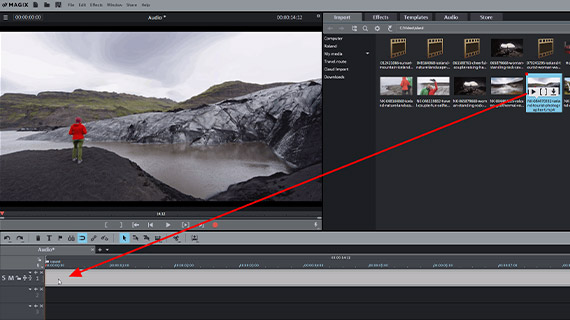
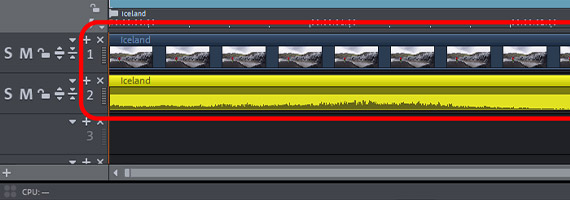
Adjusting volume of a video: Import video
- Open Movie Studio Platinum and create a new project.
- In the Media Pool in the upper right, locate the folder containing your video file.
- Drag & drop the video file into the program. To combine several videos, insert them one-by-one to the top track.
Press the spacebar to play the project back. Press it again to stop playback. The playback marker can be positioned anywhere by simply clicking the mouse button.
The video on the top track contains a video track as well as an audio track. To display the audio track, do the following:
- Right-click on the video and under the option "audio functions" > "Video/Audio on separate tracks".
Now the video and audio tracks will be shown separately. Track 1 is the video track and Track 2 is for the audio.
You can also view the waveform of the audio track to gain a better understanding of what material the audio contains:
- To do this, right-click on the audio object in track 2 and select the option "Create wave form".
A waveform will display within the audio object on this track. The waveform isn't strictly necessary when editing a voiceover, but it's recommended for how to dub audio over video, as it provides you with a clear overview of your audio material and allows for easier editing.
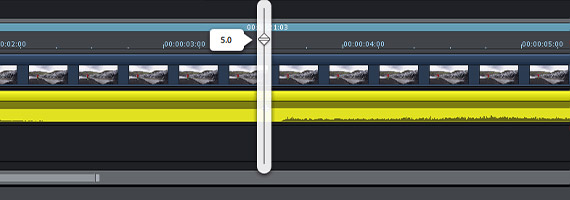
Dubbing: Adjust the volume of the audio track
To increase the volume for an audio track, you have several options to choose from: Let's start with the simplest.
- Place the mouse on the object handle in the middle of an audio object. The volume fader will display.
- Click and drag the volume envelope up while holding down the mouse button to increase the volume, or down to reduce it.
The method is especially easy. However, clipping can easily occur at loud sections. A crackling sound in your audio is an indication of clipping.
If you hear some kind of crackling or popping during playback, open the mixer via the "M" key (or in the toolbar on the right via the mixer button). Use the peak meter to check exactly where clipping occurs. The peak meter display should not exceed 0 db at any point in the track.
If it does, reduce the volume of the audio object further.
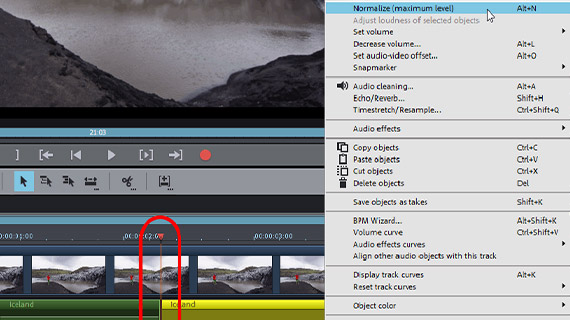
Dubbing: Increase volume automatically
It's usually best not to increase video volume manually, but to use the normalization feature. This ensures that clipping won't occur anywhere in the audio track.
- Right-click on the audio object and in the context menu that appears, select "Normalize (maximum level)".
When you adjust volume in this way, the tool you use will automatically scan the audio track for the point with the highest volume and then set it to the highest possible level of 0 db.
However, this might not be enough, since a single loud section in the audio is all it takes to "push down" the entire audio signal. For instance if you accidentally bumped the mike during recording, this single loud rumble noise will mean that all other parts stay quiet during normalization.
You can resolve this issue by cutting the audio track into sections and normalizing the cut audio objects separately. You should proceed as follows:
- Place the playback marker just before a loud section in the waveform and press the "T" key on your keyboard to split the audio track into two separate objects at this point.
- Place the playback marker after the peak and press the "T" key again. This cuts the audio object again.
You have now cut the audio track into three audio objects, which can be normalized separately. You can deal with particularly loud sections that negatively influence the master volume in this way. This will significantly increase overall volume for the video.
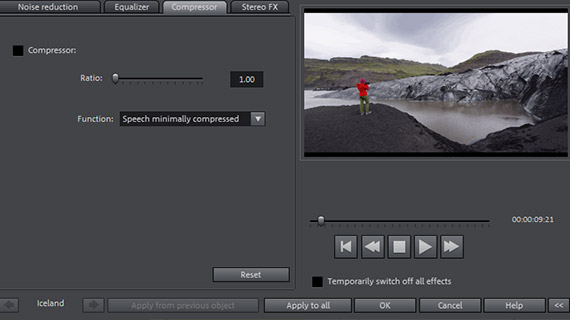
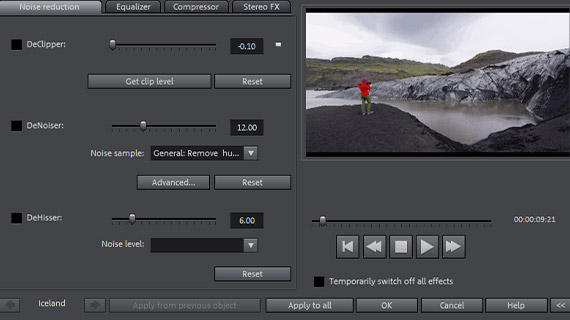
Dubbing a video with audio effects
Another possibility to increase video sound's effective loudness is by applying audio effects to audio objects.
- The compressor will increase video sound volume as an average and enhances speech intelligibility to balance out the volume levels of quiet and loud passages.
- The equalizer can be used to eliminate low rumbling, for example, by cutting the low frequencies. Or it can also be used to emphasize mids and highs thereby enhancing the sound.
- The noise reduction feature allows you to filter out background noise such as hissing, crackling or crackling from the audio track.
These optimization effects can be found in Movie Studio Platinum compiled in the "Audio Cleaning" dialog.
- In the Media Pool, open the "Effects" tab and click on the icon "Audio Effects".
- Click on the "Audio Cleaning" button in the effect dialog.
There's no need to worry about clipping when using the Compressor, since it will increase video sound of quiet passages whilst leaving loud ones unchanged. The Equalizer can create unwanted clipping. To avoid clipping in the Equalizer, it's better to proceed by making the surrounding ranges quieter. This will accentuate the frequencies you want to adjust indirectly.
Editing volume can sometimes have side effects: When parts are made louder, noise in these parts can be made much louder too. If this occurs, you can set up a noise removal process.
- Use the DeHisser to reduce background noise.
- If the results still aren't what you're looking for, use the "DeNoiser". First choose a type of noise interference (e.g. "Tape noise removal") and then set the level for the DeNoiser effect using the slider. Frequencies from the noise sample will be filtered out of the recording as a result. You can also create a noise sample directly from your video and use it for the filter.
Tip: If this seems a bit too complicated, you can take advantage of pre-configured effect presets in the "Audio effect presets" in the Media Pool. These can be used to easily modify volume and enhance sounds. You can preview each effect preset first and then simply click it to apply to the audio track.
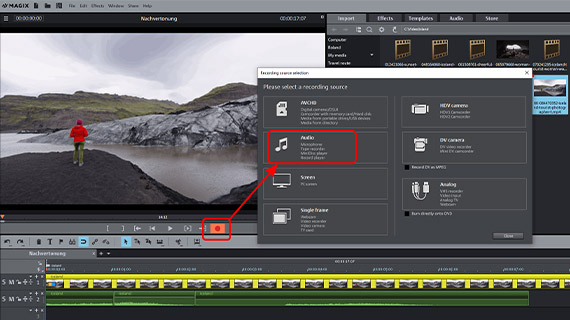
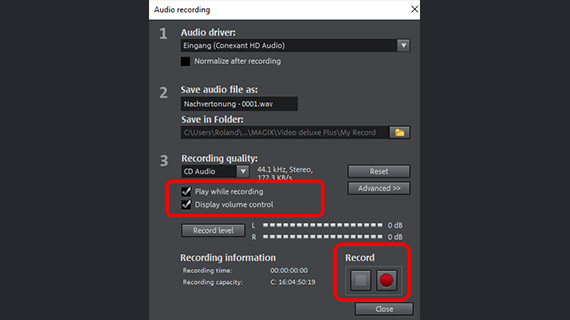
How to dub a voice in video
A spoken commentary is always useful for explaining what is happening in the video to the viewer. But it is also possible to work the other way around and use a pre-prepared or freely spoken text as the basis for the video. Then, the images in the video illustrate the spoken word.
Either way, you'll need a microphone. The built-in microphone on most camcorders is often not very good. The audio recording is then significantly lower than the high quality of the image recording. If this is the case, it is advisable to use a separate microphone. This is where inexpensive, small lapel microphones come in handy.
First, make a test recording to check whether the recording sounds good and is loud enough. Once you have connected your microphone to the computer, do the following:
- Click on the red "Record" button underneath the video preview monitor.
- Select "Audio" from the recording dialog.
- Speak into the microphone while checking the level display in the dialog. For this, be sure to tick the checkbox "Show levels". If clipping occurs, reduce the input signal. You can also speak more quietly or further away from the microphone.
- Be sure that the checkbox "Playback while recording" is activated so that you can see the video track and comment on it.
- Start your recording and click on "Stop" when you're finished.
After recording, you will be asked whether you want to add the recording to your project. You can repeat a recording as many times as desired.
After making an acceptable recording, it will be inserted as an audio object onto a free track.
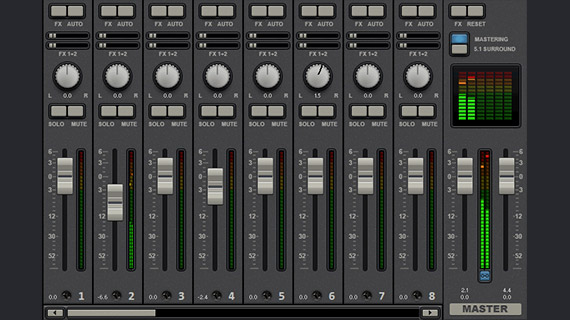
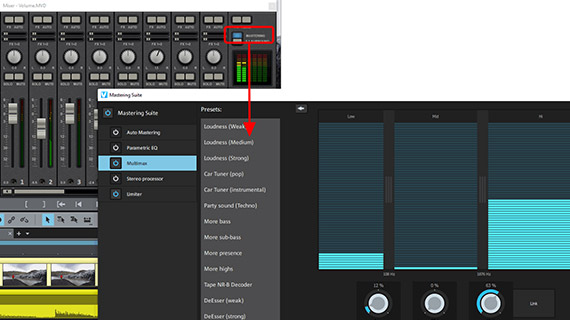
Dubbing a video using the audio mixer
Movie Studio Platinum includes a virtual mixer that offers a wide range of options for professional audio editing. It essentially allows you to mix different audio tracks together and adjust their volume. So if you for instance want to combine background music with the sound of the original video recording and perhaps add a voice-over too, the audio mixer is what you need.
It's great for editing single audio tracks too. Before, we looked at how you can use the peak meter display for identify clipping.
Every project track in the mixer contains its own volume fader. Master volume can be set in the "Master section". The master section includes two faders for adjusting levels for the left and the right channel of the stereo master signal separately.
To combine several audio tracks or videos from different sources with one another, first move all videos and audio objects one below the other on a single track. By holding down the shift key, you can adjust the videos horizontally so that the cuts don't get mixed up.
You should now have all acoustic recordings from the same source lying on their own dedicated tracks – for instance the original video sound on track 2, background music on track 3 and a voice commentary on track 4. Or in the case of multiple videos, assign all videos from camera 1 to tracks 1 + 2, videos from camera 2 to tracks 3 + 4, and so on.
- During playback, follow the peak meter display in the audio mixer. You can check volume for any track and for the overall output in this way.
- The "FX" buttons are located above on the channel strip. Via these buttons you can access all the track-based editing effects – for instance, a compressor and an equalizer.
- Via "Mastering" on the right you can open the effects for the overall sound. Here, you'll find a limiter for preventing clipping. The limiter analyzes signal peaks and eliminates distortion by bringing any levels set to over 0 db down to 0 db. With the "MultiMax" multiband compressor you can split the frequency spectrum into three ranges. Use this to keep all deeper sounds uncompressed and work only on higher frequencies by using precise compression to give them higher volume and more presence.
The effects in the audio mixer offer many options for volume and sound optimization and are unique features in Movie Studio Platinum.
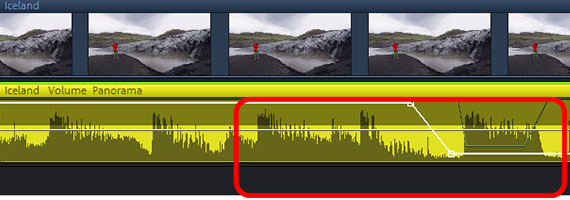
Dubbing: Adjust volume using track curves
When working with multiple audio tracks, it's often necessary to briefly lower an audio track if an important event is occurring at the same time on another audio track (this is known as "ducking"). This can be achieved in Movie Studio Platinum using what are known as volume curves. A volume curve is useful for editing single audio tracks too, when you want to increase video sound volume during playback.
Working with volume curves means that there are no instances of clipping, because object volume can only be reduced and not increased.
- Activate the volume curve in the context menu of the audio track (right-click in the audio object >"Volume curve"). A curve will appear in the project window as a thin line within the audio object.
- Double-click on the curve and curve handles will appear.
- Move the curve handles up and down to increase or lower the volume respectively.
Example: A "U" shape temporarily lowers the volume and then increases it again (ducking). For this you'll need a total of four curve handles: Leave the outer two handles the way they are and drag the middle two handles downwards. Controlling volume in this way is ideal when you want certain audio events from the original recording – for instance a sudden noise on a separate track added during post production – to be clearly audible. This "ducks" the background sound briefly so that the noise is heard, then the volume of the music increases again.
Tip: Movie Studio Platinum offers helpful functions for automatic volume reduction ("Auto Ducking"). First, cut the sequence in which the distortion you wish to correct is found into an independent video. Right-click this object and choose "Volume reduction" from the shortcut menu. In the dialog, you can define to what extent the volume of the other tracks should be lowered.
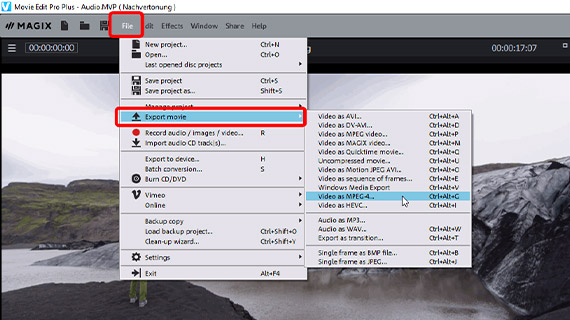
Audio dubbing – Export
Finally, when you've balanced volume of the audio tracks and enhanced sound, you can export your video. There are several ways to do this:
- Create video file: Go to "File" > "Export movie" to create a new video file e.g. in MP4 or MOV format. There are a range of codec settings and presets available in the Export dialog.
- Burn to disc: You can also burn your footage to disc from right within the program. DVD, AVCHD and Blu-ray Disc are all available. To open the "Burn" interface, click to the right on the button with the disc icon. Pick a selection menu layout and type of disc, then start the burn process.
- Upload to the Internet: Vimeo and YouTube are directly connected to the program. Click on the arrow symbol in the top right to open the dialog "Finish movie" and upload the video to your profile.
- Transfer to smartphone: In the "Finish movie" dialog you will see the option "Export to mobile device". Here you simply pick a device, Movie Studio Platinum sets the parameters automatically. The video will be exported first in the correct format, and then output to your device.




Dubbing audio to video using Movie Studio, the video editing software for downright amazing movies:
- Import all common audio and video formats
- Custom volume control via object handles
- Audio mixer for multiple audio tracks
- Increase volume using audio effects (normalization, compressor, 1-click effect templates)
- Mastering with multiband compressor for professional volume editing
- Track curves for dynamic volume control
- Helpful program wizards
- File conversion into all essential formats, CD burn function and direct transfer to smartphone


